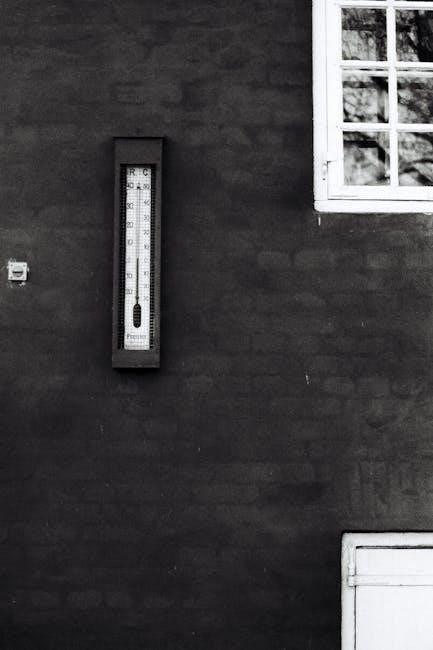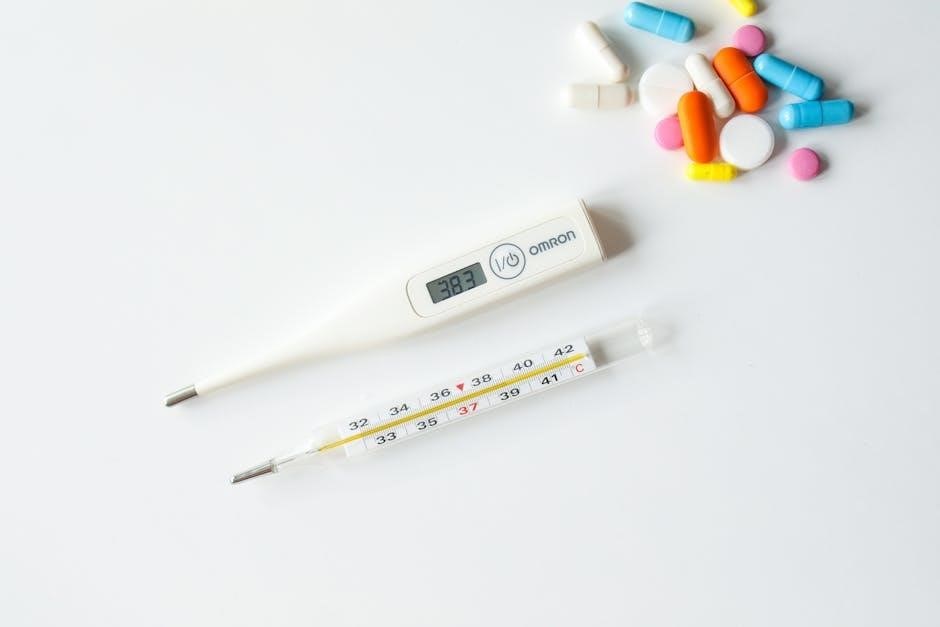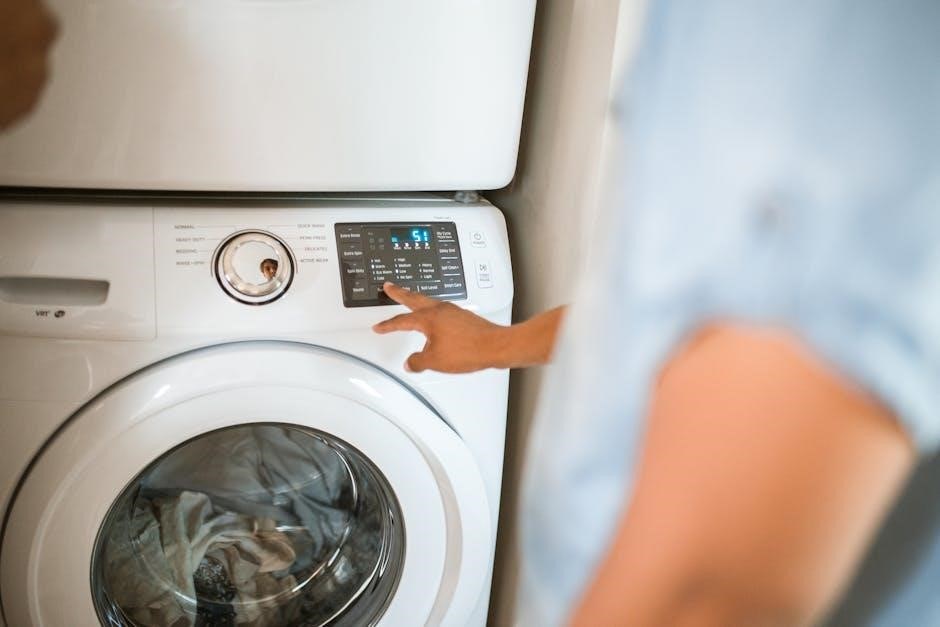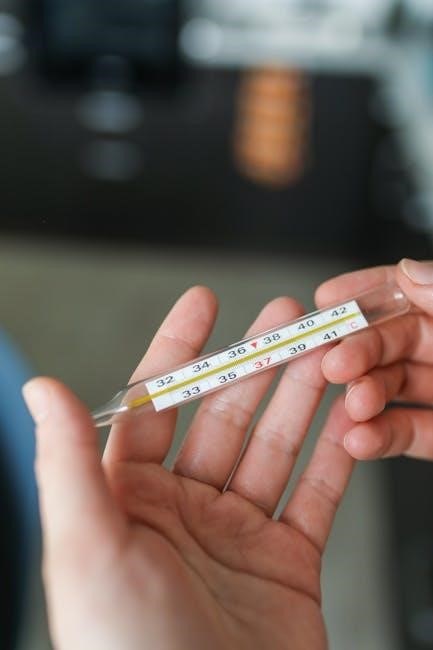Welcome to the Redi Thermometer guide! This manual helps you master the ET-732 and ET-733 models, offering wireless monitoring and programmable settings for precise temperature control.
1.1 What is a Redi Thermometer?
A Redi Thermometer is a wireless BBQ and meat thermometer designed for precise temperature monitoring. Models like the ET-732 and ET-733 offer remote monitoring via radio frequency, ensuring accurate readings. These devices are programmable, allowing users to set specific temperature goals for various meats. The thermometers come with probes that can be inserted into food or ambient areas, providing real-time data. They are ideal for grilling, smoking, and cooking, ensuring perfectly cooked results every time. The Redi Thermometer is a must-have tool for both novice and experienced cooks, offering convenience, accuracy, and reliability in temperature control.
1.2 Importance of Using a Thermometer for Cooking
Using a thermometer for cooking is essential for achieving perfectly cooked dishes every time. It ensures food safety by preventing undercooking or overcooking, which can lead to health risks or poor flavor. A thermometer like the Redi Thermometer allows precise temperature control, crucial for meats, poultry, and fish. It helps avoid guesswork, ensuring dishes are cooked to the ideal internal temperature. This is especially important for BBQ and grilling, where consistent results are key. By using a thermometer, you can achieve professional-level cooking outcomes, making it a vital tool for both novice and experienced cooks. It enhances efficiency and confidence in the kitchen.
1.3 Key Features of the Redi Thermometer
The Redi Thermometer is designed with advanced features to enhance your cooking experience. It includes wireless monitoring, allowing you to track temperatures remotely, and programmable settings for precise control. The device supports multiple probes, enabling simultaneous monitoring of food and ambient temperatures. Its large, backlit display ensures readability in any lighting conditions. The thermometer is also equipped with a long battery life and durable construction for lasting performance. Additional features include customizable alerts for temperature thresholds and a user-friendly interface. These features make the Redi Thermometer an essential tool for achieving consistent and delicious results in BBQ, grilling, and other cooking methods. Its versatility and reliability set it apart as a must-have for both home cooks and professionals.

Installation and Setup
Start by unboxing and inspecting the Redi Thermometer. Insert the batteries, ensuring correct polarity. Sync the probes with the thermometer for accurate readings. Complete the setup to begin using your device effectively.
2.1 Unboxing and Initial Inspection
Welcome to the setup guide for your Redi Thermometer! Upon unboxing, carefully inspect the device for any visible damage. Ensure all components, including the thermometer, probes, and batteries, are included. Check the probe wires for integrity and verify the battery compartment is intact. Familiarize yourself with the display screen and buttons. This step ensures proper functionality and helps identify any issues before use. If any parts are missing or damaged, contact customer support immediately. A thorough inspection now guarantees smooth operation later. Take your time to review every component, as this lays the foundation for accurate temperature monitoring and optimal performance.
2.2 Battery Installation for the Redi Thermometer
Installing batteries in your Redi Thermometer is a straightforward process. Locate the battery compartment, typically found on the back or bottom of the device. Open the compartment by sliding the cover off or unscrewing it, depending on the model. Insert the required AA batteries, ensuring the positive and negative terminals align correctly. Replace the cover securely to avoid any gaps. Avoid mixing old and new batteries to maintain consistent power. Once installed, turn on the thermometer to test functionality. Proper battery installation ensures accurate readings and reliable performance. If the device does not turn on, double-check the battery orientation and connections. This step is crucial for optimal operation.

2.3 Syncing the Thermometer with Probes
Syncing your Redi Thermometer with its probes ensures accurate temperature readings. Start by turning on the thermometer and attaching the probes to the appropriate ports. Press and hold the sync button, usually located on the back or side, for 2-3 seconds until the device beeps or the screen indicates syncing. Repeat this process for each probe if your model supports multiple sensors. Once synced, the thermometer will display readings from the probes. If syncing fails, ensure the probes are properly connected and try again. For wireless models, syncing may involve pairing the probes via the device’s menu. Proper syncing is essential for reliable performance during cooking or monitoring temperatures.

Operating the Redi Thermometer
Learn to operate your Redi Thermometer with ease. Turn it on, set alerts, and use probes for precise readings. Understand the display for optimal cooking results.
3.1 Turning On the Thermometer
To turn on your Redi Thermometer, locate the power button, usually found on the top or side of the device. Press and hold it for 2-3 seconds until the display lights up. Ensure the battery is correctly installed, as outlined in section 2.2. Once powered on, the thermometer will enter standby mode. For initial setup, navigate through the menu to set your preferred temperature units (Celsius or Fahrenheit). The ET-732 and ET-733 models feature a user-friendly interface for easy operation. After turning on, the device is ready to pair with probes or begin monitoring temperatures. Always ensure the thermometer is turned off after use to conserve battery life.
3.2 Setting Temperature Alerts

To set temperature alerts on your Redi Thermometer, navigate to the temperature settings menu. Use the HI/CLEAR and LO/CLEAR buttons to adjust the desired temperature. Press and hold HI/CLEAR for 2 seconds to increase the target temperature in 10-degree increments. Similarly, press and hold LO/CLEAR to decrease it. Once your desired temperature is set, press the DONE button to confirm. The thermometer will alert you when the food reaches the set temperature. This feature is ideal for preventing overcooking and ensuring perfectly cooked meals. Make sure to test the alert function before cooking to ensure it works correctly. Properly set alerts enhance your cooking experience and guarantee food safety. Always refer to the manual for additional customization options.
3.3 Using the Probe for Accurate Readings
For accurate readings, insert the probe into the thickest part of the food, avoiding fat or bone. Ensure the probe is fully inserted to prevent exposure to direct heat. Use the clip to secure the probe to the food if necessary. Sync the probe with the thermometer by following the pairing instructions in the manual. Once connected, monitor the temperature on the display screen. Avoid touching the probe tip during cooking to prevent damage. Regularly clean the probe to maintain accuracy. Proper probe placement ensures precise temperature readings, helping you achieve perfectly cooked dishes every time. Always refer to the manual for specific probe care instructions.
3.4 Understanding the Display Screen
The Redi Thermometer features a clear LCD display showing current temperature, set temperature, and status indicators. The screen displays real-time data from connected probes, ensuring precise monitoring. Use the navigation buttons to scroll through options. The display also shows alerts when the set temperature is reached. Battery life indicators are visible, ensuring you never run out of power unexpectedly. The screen is backlit for easy reading in low-light conditions. Familiarize yourself with the symbols, such as the Bluetooth icon for wireless connectivity. Understanding the display ensures seamless operation and accurate temperature control. Refer to the manual for detailed explanations of all screen elements and their functions.
Maintenance and Care
Regularly clean the thermometer with a soft cloth and mild soap. Store it in a dry place, away from direct sunlight. Replace batteries as needed.
4.1 Cleaning the Thermometer
Cleaning your Redi Thermometer is essential for accuracy and longevity. Use a soft, dry cloth to wipe the display and exterior. For tougher stains, dampen the cloth with mild soap, but avoid submerging the device. Probes should be cleaned with a damp cloth and mild soap after each use to prevent residue buildup. Never use abrasive cleaners or harsh chemicals, as they may damage the surface. After cleaning, ensure all parts are thoroughly dry before storing or using the thermometer again. Regular cleaning prevents cross-contamination and ensures precise temperature readings. Always handle the thermometer with care to maintain its performance and extend its lifespan.
4.2 Storing the Thermometer Properly
Proper storage of your Redi Thermometer ensures its accuracy and longevity. Store the device in a cool, dry place, away from direct sunlight and moisture. Use the original case or a protective cover to prevent scratches and damage. Avoid extreme temperatures, as they may affect the thermometer’s calibration. Keep the probes separate from the main unit to prevent tangling or bending. If storing for an extended period, remove the batteries to avoid leakage. Ensure all components are clean and dry before storage to prevent mold or corrosion. By following these steps, you can maintain your Redi Thermometer in optimal condition for future use.
4.3 Replacing Batteries
To replace the batteries in your Redi Thermometer, start by sliding off the battery cover, usually located on the back or bottom of the device. Gently remove the old batteries and dispose of them properly. Insert the new batteries, ensuring they are placed correctly according to the polarity markings inside the compartment. Use high-quality alkaline batteries for optimal performance. Once the new batteries are in place, securely close the cover. Avoid mixing old and new batteries or using rechargeable ones, as this may affect accuracy. If the thermometer has multiple components, such as probes, ensure their batteries are also replaced if necessary. Proper battery replacement ensures reliable temperature readings and extends the lifespan of your Redi Thermometer.
Advanced Features of the Redi Thermometer
The Redi Thermometer offers programmable temperature settings, wireless monitoring, and data tracking, enabling precise control and remote monitoring of your cooking process for optimal results.
5.1 Programmable Temperature Settings
The Redi Thermometer allows you to set custom temperature profiles for various meats and cooking methods. Using the HI/CLEAR button, you can adjust the maximum food temperature. Press and hold for 2 seconds to increase the value by 10 degrees. This feature ensures precise control over your cooking process. For example, you can program different settings for beef, poultry, or fish. The thermometer will alert you once the desired temperature is reached, ensuring perfectly cooked dishes every time. This programmable function is especially useful for achieving consistent results in smoked or grilled foods. It simplifies the cooking process and enhances your culinary experience.
5.2 Wireless Monitoring
The Redi Thermometer offers wireless monitoring, allowing you to track temperatures remotely. With a range of up to 300 feet, you can monitor your cook from a distance. This feature is ideal for long cooking sessions, such as smoking or grilling. The thermometer transmits real-time data to a receiver, ensuring you stay informed without constant supervision. Simply pair the device with the receiver, and you’ll receive alerts when your food reaches the desired temperature. This convenience enhances your cooking experience, letting you focus on other tasks while maintaining perfect control over your dish. Wireless monitoring is a standout feature that makes the Redi Thermometer a versatile tool for home cooks and professionals alike.

5.3 Data Tracking and Storage
The Redi Thermometer allows for advanced data tracking and storage, enabling you to monitor and record temperature readings over time. This feature is particularly useful for tracking the progress of long cooking sessions, such as smoking or roasting. The device stores historical data, which can be accessed later to analyze cooking patterns and refine techniques. With a user-friendly interface, you can easily review past sessions and identify trends. Additionally, the thermometer supports data export to external devices, making it simple to share or archive your cooking data. This functionality is ideal for both home cooks and professionals, providing valuable insights to enhance your culinary skills.

Troubleshooting Common Issues
Resolve connectivity problems by restarting the device or checking probe connections. Address inaccurate readings by calibrating the thermometer or replacing faulty probes as needed.
6.1 Resolving Connectivity Problems
Experiencing connectivity issues with your Redi Thermometer? Start by ensuring the device and probes are properly synced. Restart the thermometer and check battery levels. If problems persist, reset the device by holding the HI/CLEAR button for 5 seconds. Ensure probes are securely connected and within range. For wireless models, verify the receiver is turned on and batteries are fresh. If issues remain, refer to the manual for resetting to factory settings. Regularly updating firmware can also resolve connectivity glitches. Always ensure the thermometer and probes are compatible with your model. If none of these steps work, contact customer support for further assistance.
6.2 Fixing Inaccurate Temperature Readings
If your Redi Thermometer is providing inaccurate readings, start by recalibrating it. Press and hold the HI/CLEAR button for 5 seconds to reset the device. Ensure the probe is clean and free from damage. Check that the probe is fully inserted into the thermometer port. If using a wireless model, verify the probe is synced correctly. Replace the batteries if they are low, as this can affect accuracy. Avoid placing the probe near fat or bone, as this can skew results. For persistent issues, refer to the manual for calibration instructions or contact customer support. Regular maintenance ensures precise measurements. Always follow the manufacturer’s guidelines for optimal performance.
6.3 Addressing Battery Life Concerns
If your Redi Thermometer’s battery life is a concern, start by ensuring you’re using high-quality, non-rechargeable batteries. Avoid mixing old and new batteries, as this can reduce performance. If the low-battery warning appears, replace the batteries promptly. For models like the ET-732 and ET-733, slide off the battery cover and install new batteries correctly, following the polarity markings. Avoid exposing the thermometer to extreme temperatures, as this can drain batteries faster. Turn off the device when not in use to conserve power. If issues persist, check for firmware updates or contact customer support. Proper battery maintenance ensures reliable performance and accurate temperature readings. Always store spare batteries in a cool, dry place to maintain their effectiveness.
Safety and Precautions
Always handle the Redi Thermometer with care to avoid damage. Keep it away from children and ensure probes are placed correctly to prevent accidents. Avoid exposing the device to extreme temperatures or moisture, as this can compromise accuracy and safety. Regularly inspect the thermometer and probes for damage. Never submerge the device in water, and avoid touching hot surfaces with the probes. Follow all instructions carefully to ensure safe and effective use. Proper handling and storage will extend the lifespan of your Redi Thermometer and maintain its reliability in cooking applications.
7.1 Handling the Thermometer Safely
Handling the Redi Thermometer safely is crucial for optimal performance and longevity. Always avoid exposing the device to extreme temperatures or moisture, as this can damage the internal components. When using the probes, ensure they are placed correctly to prevent accidental contact with hot surfaces or open flames. Never submerge the thermometer in water, as it is not fully waterproof. Keep the device out of reach of children to avoid any potential hazards. Regularly inspect the thermometer and probes for signs of wear or damage. Proper handling ensures accurate readings and prevents malfunctions. By following these guidelines, you can maintain the reliability and safety of your Redi Thermometer during cooking and monitoring tasks.
7.2 Avoiding Common Mistakes
To ensure optimal performance and longevity of your Redi Thermometer, avoid common mistakes during use. Never expose the device to extreme temperatures or moisture, as this can damage the internal components. Avoid placing the probes incorrectly, as this may lead to inaccurate readings or damage to the sensor. Do not submerge the thermometer in water, as it is not fully waterproof. Additionally, avoid touching hot surfaces or open flames with the probes, as this can cause burns or malfunction. Always handle the device gently and keep it away from children. Regularly inspect the thermometer and probes for wear or damage. By avoiding these common errors, you can ensure precise measurements and extend the life of your Redi Thermometer.
7.3 Proper Placement of Probes
Proper placement of the Redi Thermometer probes is crucial for accurate temperature readings. Always insert the probe into the thickest part of the meat, avoiding fat or bone, as this can lead to incorrect measurements. Ensure the probe is not touching any hot surfaces, such as grills or pans, to prevent damage. For wireless models, place the receiver away from direct heat sources to maintain signal strength. Avoid exposing probes to extreme temperatures or moisture, as this can compromise their accuracy. Handle the probes gently to prevent bending or breaking. Regularly inspect the probes for damage and clean them thoroughly after each use. Proper placement ensures reliable results and extends the lifespan of your Redi Thermometer.

Frequently Asked Questions (FAQs)
This section addresses common queries about the Redi Thermometer, ensuring optimal performance and troubleshooting. Find answers to basic usage, advanced features, and maintenance-related questions here.
8.1 Basic Usage Questions

Congratulations on purchasing the Redi Thermometer! This section answers common questions about its basic operation. How do I turn it on? Press and hold the power button until the screen lights up. How do I set temperature alerts? Use the HI/CLEAR button to adjust the maximum temperature, then press SET to confirm. Can I use multiple probes? Yes, the Redi Thermometer supports up to two probes for simultaneous monitoring. How do I ensure accurate readings? Insert the probe into the thickest part of the meat, avoiding fat or bone. For more details, refer to the manual or manufacturer’s guide.
8.2 Advanced Functionality Queries
For advanced users, the Redi Thermometer offers features like programmable temperature settings and wireless monitoring. How do I set custom temperature profiles? Use the HI/LOW buttons to define your desired range, then press SET. Can I monitor temperatures remotely? Yes, the ET-733 model supports wireless monitoring via radio frequency. How do I track cooking data? The thermometer stores temperature history, accessible via the MENU button. Can I sync multiple probes? Yes, you can connect up to two probes for simultaneous monitoring. For more details on these features, refer to the manual or manufacturer’s guide for optimal use.
8.3 Troubleshooting FAQs
Why isn’t my Redi Thermometer connecting to the probes? Ensure the probes are properly synced and batteries are installed correctly. How do I fix inaccurate temperature readings? Calibrate the thermometer or replace the batteries if they are low. Why is the display not turning on? Check the battery installation and ensure they are not depleted. Can I reset the thermometer to factory settings? Yes, press and hold the HI/CLEAR button for 5 seconds. Why is the wireless signal weak? Move the receiver closer to the transmitter or reduce interference. For more solutions, refer to the manual or contact support.

Conclusion
Mastering your Redi Thermometer ensures precise cooking and optimal performance. Follow these guidelines for accurate results and extend the product’s lifespan with proper care and maintenance.
9.1 Summary of Key Instructions
This guide provides a comprehensive overview of the Redi Thermometer, from installation to advanced features. Start by unboxing and inspecting the device, then install batteries and sync probes. Learn to operate the thermometer by turning it on, setting alerts, and using probes for accurate readings. Understand the display screen for clear temperature monitoring. Maintain your device by cleaning it regularly, storing it properly, and replacing batteries as needed. Explore advanced features like programmable settings and wireless monitoring for enhanced convenience. Troubleshoot common issues like connectivity problems or inaccurate readings. Always handle the thermometer safely, avoid mistakes, and place probes correctly. By following these steps, you’ll ensure optimal performance and longevity of your Redi Thermometer.
9.2 Final Tips for Optimal Use
To maximize your Redi Thermometer’s performance, always calibrate it regularly for accuracy. Store probes in a dry, protected area to prevent damage. Replace batteries promptly when low to avoid sudden shutdowns. Use the correct probe type for specific foods to ensure precise readings. Keep the device away from direct heat sources to maintain longevity. Refer to the manual for software updates to access new features. Experiment with programmable settings to tailor temperature monitoring to your needs. For wireless models, ensure a stable connection to avoid signal loss. Clean the thermometer after each use to prevent residue buildup. By following these tips, you’ll enjoy consistent, reliable results and extend the life of your Redi Thermometer.

No Responses